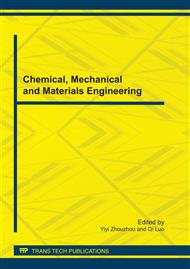p.1
p.7
p.13
p.19
p.25
p.29
p.35
p.43
Synthesis of CdS/CdCO3 Core/Shell Structural Nanocrystals Potentially Used for Solar Cell via Hydrothermal Route
Abstract:
Synthesis of CdS/CdCO3 Core/Shell semiconductor nanocrystals potentially used for solar cell via hydrothermal route is presented. Water-soluble crystallites with wurtzite crystal structure (CdS), hexagonal structure (CdCO3) with strong photoluminescence are prepared. The synthesis is based on the separation of the nucleation and growth stages of core and shell by controlling some crucial factors such as temperature, pH, ratio and concentration of reactant mixture. Bare wurtzite structural CdS nanocrystallites were synthesized by using cadmium acetate and thiourea as precursors. Ostwald ripening process under high temperature leads to high sample quality. Photoluminescence of nanocrystals with Core/Shell Structure and bare nanocrystals was compared and analysed. Nanocrystals with Core/Shell Structure have stabler performance of photoluminescence than CdS bare nanocrystallites because of the shell. Transmission electron microscopy and X-ray powder diffraction indicate the presence of bulk structural properties in crystallites as small as 5nm in diameter. X-ray Photoelectron Spectroscopy was used to characterize core/shell structure of as-prepared NCs. Ultra-stability and super strong photoluminescence emission of as-prepared CdS/CdCO3 Core/Shell semiconductor nanocrystallites indicates its potentially practical value in NCs solar cell.
Info:
Periodical:
Pages:
7-12
Citation:
Online since:
July 2011
Authors:
Price:
Сopyright:
© 2011 Trans Tech Publications Ltd. All Rights Reserved
Share:
Citation:



